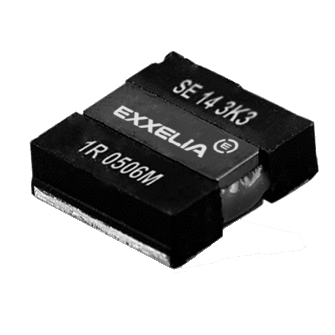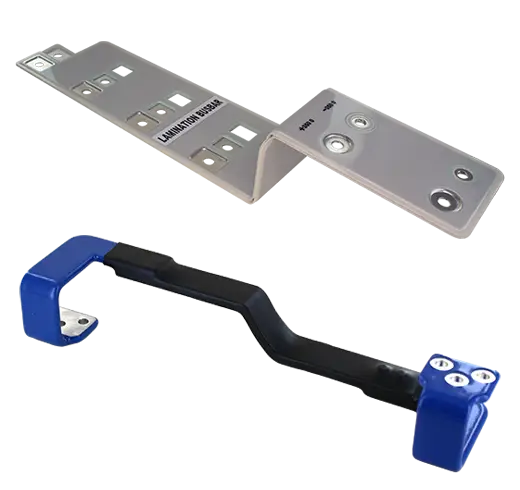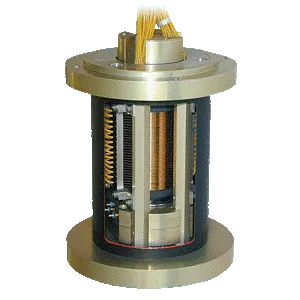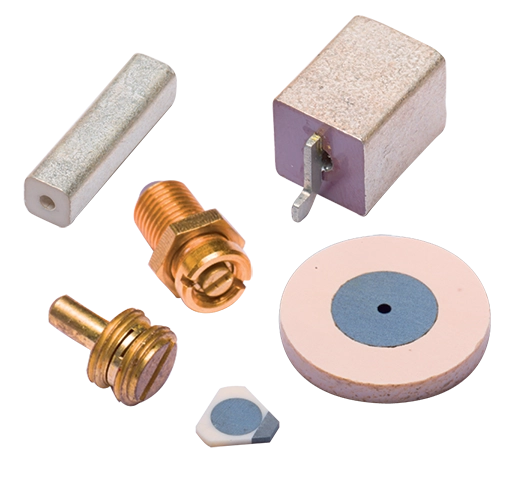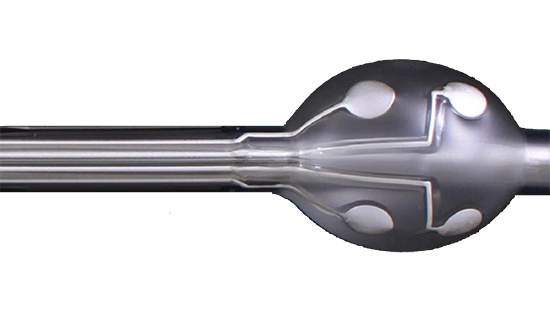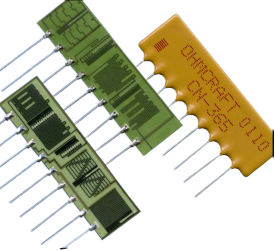

Custom Design
Spec-tacular
Designs
Exxelia provides support from drafting the product specification to evaluation and validation testing up to full production ramp-up.
We excel in tailoring our designs to meet unique specifications, from performance parameters to physical dimensions. Our flexibility extends to adapting various casing types, terminations and assembly process, ensuring optimal integration for every project.
Customize it
Design forms
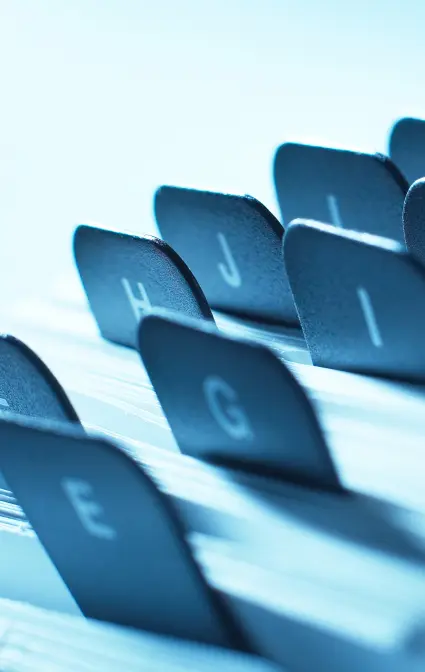
Frequently Asked Questions
A three-section filter consisting of two feedthrough capacitors to ground with a series inductor between them. The Pi filter is usually symmetrical, as are all the Pi filters in this catalog, but circumstances sometimes warrant use of asymmetrical Pi circuits. A Pi filter has attenuation characteristics that increase at 60 dB per decade from its cutoff frequency to at least that frequency where it exhibits a minimum attenuation of 80 dB. It maintains this level at higher frequencies.
Pi-Only Filters are the choice when high levels of attenuation are required and both the input & output impedances are similar.
WET tantalum capacitors are known for their significantly higher energy density, reaching up to 1000 J/dm³ compared to the mere 12 J/dm³ of solid tantalum capacitors. They also have the advantage of higher voltage ratings, supporting up to 150 V, and can operate at much higher temperatures, up to 200°C.
On the other hand, solid tantalum capacitors offer benefits such as miniaturization, high long-term stability, and very low equivalent series resistance (ESR), making them ideal for applications requiring compact and reliable components.
These capacitors offer a very high charge per unit of volume, a long lifetime and a high reliability. They are used in consumer goods and more specialized niches including space vehicles, aircraft electronics, weapons and rail transport. Exxelia develops both solid and wet tantalum capacitors.
A tantalum capacitor is a specific type of electrolytic capacitor. It is made from a metal called tantalum, which is where it gets its name. Tantalum acts as an anode. The capacitor itself is covered in a thin layer of oxide, which allows it to act as the dielectric. It is surrounded by a conductive cathode. One of the major benefits of tantalum capacitors is that their design allows for a very thin layer of dielectric, which allows for higher capacitance than other types of capacitors made from different types of materials. These types of capacitors are generally polarized, which means that in practice they can only be connected to a direct current power supply that has been designed while observing the appropriate terminal polarity. They have excellent stability over time and superior frequency characteristics when compared to different types of similar capacitors that are made from different materials.
Standard silver mica capacitors are normally designed to handle voltages from 100 to 1000 volts. High-voltage RF transmitter applications can call for higher tolerances. Mica capacitors are available for voltages up to 20kV.
Our expert engineering team can create the mica capacitor with the characteristics you require. Send us your drawing or file and we will work with you to manufacture the correct size, lead style and capacitance you desire.
Silver mica capacitors provide superior stability and low loss when used in RF power circuits that require low pico farad (pF) and nano farad (nF) ranges. Older silver mica capacitors were manufactured in layers of mica and silver, but the layering allowed room for air gaps that reduced the stability and could also create stress fractures in the assembly.
Modern manufacturing uses silver plated to mica layers, eliminating the gaps. When the desired number of layers is obtained, the assembly is coated in an epoxy or ceramic resin. The coating reduces fracturing of the layers and seals the assembly from moisture and particles that could interfere with the capacitance value.
Mica capacitors are useful in circuits for ripple filtering and are often found in time constant, coupling or resonance circuits. In addition to radio circuits, they are used in TV transmitters and Cable TV amplification circuits. Mica is also a superior choice in high-voltage inversion and power conversion for energy absorbing snubber applications with capacitances of up to 10 nF.
This natural mineral insulator has outstanding dielectric properties that are ideal for long-life high-stability capacitors with low loss at all frequencies, and high dielectric strength. This type of capacitor is used particularly for high frequency and delay line applications, oscillating circuits, emission devices and calibrators.
Mica dielectric capacitor technology allows for several custom design applications including:
- High voltage capacitors (up to 50 kV)
- High temperature capacitors (up to 250°C)
- Precision capacitors (up to ± 0.1%)
- High stability capacitors (– 20 + 30 ppm/°C)
- High frequency capacitors ( up to several GHz).
The majority of these capacitors are manufactured to comply to specifications NF-C-83120;MIL-C-5 and MIL-PRF-39001 standards.
Mica capacitors are noted for the following characteristics:
- Temperature performance
- Low loss at all frequencies
- High dielectric strength
- Stability over time
If you need any additional information, check out the list of Exxelia Sales Representatives that are in operation across the world. You can also view the list of our Distributors to find out more information about the distributors who are operating nearest to your location.
Please do not hesitate to contact us if you have any additional questions regarding our company or the products and services that we provide. Using your web browser you can contact us in a number of different ways, including to request a quote, send us a file or drawing or send us an email. We look forward to hearing from you.
High voltage capacitors can be made from a few different types of material. High voltage ceramics capacitors and metalized polyester film capacitors are just two of the main types. They are notable for a few different characteristics:
Charge time – Even though different types of technology are at work with regards to the way high voltage types of capacitors operate, they still have both discharge and charge times that are very comparable to those of regular capacitors. These charge times are possible due to the low internal resistance in the materials at play.
Specific power – Another main characteristic that sets these types of capacitors apart is specific power, which means that they have a specific power of up to ten times larger than regular batteries.
Cycle life and safety – High voltage capacitors are much safer than traditional capacitors and batteries, even when they’re being mistreated. A traditional battery, for example, has been known to fully explode if it is short circuited, experiences excessive heat or is involved in other types of situations.
Unlimited charging – High voltage capacitors can also be charged and discharged a virtually unlimited number of times. Traditional capacitors and batteries can only be charged around 500 times before they start to lose some of their original power.
Because of these reasons, high voltage capacitors made from all types of materials are very useful during situations where energy needs to be stored and released on a frequent basis.
Our high voltage capacitors are specifically designed to be able to withstand a larger amount of electrical charge than other types of capacitors can offer. They use two main mechanisms to store the energy that is being transmitted, which is contrary to the conventional dielectric method that is used with other types of capacitors. The first main method used to store electricity is called double layer capacitance, while the second is called pseudo capacitance. These methods are electrostatic and electrochemical in origin, respectively, which allows high voltage capacitors to combine the energy storing methods of normal capacitors with the methods used during the operation of a normal battery.
The main goal of high temperature capacitors is to allow for stable performance of electrical equipment at high temperatures. They are also involved heavily in applications that require a high level of reliability. Though there are a wide variety of different capacitors and types of technologies that are available depending on the needs of the situation, only a few are available that can operate in a reliable way once temperatures become elevated.
High temperature capacitors made out of materials like ceramic or tantalum are usually employed when an application begins to operate at a temperature near or above 350 degrees Fahrenheit.
High temperature ceramic capacitors and high temperature mica capacitors are often used in situations that require a higher voltage or a higher power than normal. Because of the ways in which they are built, they can offer low ESR and excellent inrush current and ripple capabilities that other types of capacitors cannot. The only downside is that they tend to be physically larger than other types of capacitors.
The automotive industry is another area where high temperature capacitors are required. The temperature conditions can vary dramatically depending on what area of a car you’re talking about. The brake systems, the engine and the transmission are often the most temperature intensive areas.
High temperature tantalum products are designed for use in situations where you might be using down-hoe drilling equipment, for example. They are ideal for this type of input and output due to their capabilities for high ripple current. They have also been known to have the additional benefit of current values that offer lower leakage compared to other types of capacitor technologies.
High temperature capacitors have a wide variety of different uses depending on the industry. In avionics, for example, they are required to fulfill a large number of different tasks. The operating temperature of avionics equipment can vary significantly depending on their location, ranging from anywhere between 130 degrees Fahrenheit to 390 degrees or more. As a result, these types of capacitors are used to power electronics like motor controls, landing systems, fuel pumps and more. The high temperature capacitors will help make sure that these types of equipment can both withstand the extensive heat cycling and go through a long operational life.
When you’re performing any type of application, it is always important to consider the type of capacitor that you choose to use very carefully. High temperature tantalum capacitors and high temperature ceramic capacitors are just two of the main types that are available to work reliably at high temperatures where other types of solutions might fail.
Exxelia has a long history providing high temperature capacitors to various industries. Several dielectrics, such as plastic (PTFE; PI; & PEI), reconstituted mica, aluminum electrolytic, tantalum and ceramic are used for manufacturing high temperature capacitors. Many are impregnated with solid thermo-setting resins such as epoxy, polyester or silicone.
These technologies provide very high stability of mechanical and electrical characteristics with temperature capabilities of -55°C to as high as +230°C, depending on the dielectric technology, and some do not require voltage de-rating. Rated voltages span from 30 VDC to as high as 60,000 VDC with capacitance ranges 100pF to 30µF.
A three-section filter consisting of two series-connected inductors between the input and output terminals, with a feedthrough capacitor between them from line to ground. The T filter is usually symmetrical (identical inductive elements), but circumstances sometimes warrant use of asymmetrical circuits. A T filter has attenuation characteristics that increase at 60 dB from its cutoff frequency to at least that frequency where it exhibits a minimum attenuation of 60 dB.
T-only filters are the choice when both the input and output impedances are low.
Ceramic chips are created with binders and solvents added to a specified ceramic powder. The slurry created is dried, forming a sheet or tape of ceramic material. Metal powder is mixed with solvents and additional ceramic material to create a liquid electrode. The liquid is then printed onto the ceramic layer. Layers of the ceramic sheets are stacked and laminated to form a solid structure.
The solid structure is cut into the desired size. Once cutting is complete, the assembly must be kiln fired. The temperature used in the firing process is critical in determining the capacitor’s characteristics. The process is similar for disc and chip styles. Disc capacitors use long leads to mount through circuit boards. Chips use surface mount technology.
Two elements: a feedthrough capacitor from line to ground, and an inductor connected in series with it between the input and output terminals.
The capacitive element can be placed on either the line or load side of the filter, making it either a capacitive or inductive input. Its attenuation increases at 40 dB per decade from its cutoff frequency to at least that frequency where it exhibits a minimum attenuation of 70 dB. It maintains this level at higher frequencies. They are commonly referred to as L filters:
- L1 indicates that the inductive element is on the end with the threaded mounting neck.
- L2 indicates that the capacitive element is on the end with the threaded mounting neck. L-Only Filters or LL are used when the difference between line and load impedance is large.
The inductive element is best placed so that it faces the lower impedance.
It is built as a single element: a capacitor from line to ground, with a through wire connecting the input to output. It has attenuation characteristics that increase at 20 dB per decade from its cutoff frequency to at least that frequency where it exhibits a minimum attenuation of 60 dB. It maintains this attenuation at higher frequencies. A feedthrough capacitor filter is usually the best choice for filtering lines that exhibit very high impedance. A feedthrough capacitor, in this website, will be referred to as a C filter.
C-Only Filters are the choice for very high impedance lines.
Exxelia’s film capacitor product lines include a wide array of custom designs using state of the art technologies combined with the latest developments in dielectric films (including polyester, polypropylene, PPS, and teflon). Kraft/paper, foil capacitor, and metallized film capacitor products are available. This allows Exxelia to provide high temperature capability; high voltage ratings; precision capacitors with ± ¼% tolerances, and exceptional performance in harsh environments. Military film capacitors are tested and qualified to military standards, with more than 30 military qualified products. Film capacitors are exceptional for pulse/storage, DC link, energy discharge, and custom applications.
A wide selection of packaging designs are available such as film-wrapped, pre-molded epoxy cases, and hermetically sealed metal cases. Exxelia continues to research and develop film caps with new methods in capacitor manufacturing to provide durable designs and packaging schemes for special environmental use.
Film capacitors are used in a wide variety of different industry, including with military technology and applications as well as the aerospace industry. This is mainly due to the fact that they have high long term stability, can be produced relatively cheaply and are heat resistant.
One of the main characteristics of our film capacitor comes from the fact that they are not polarized. Due to this design element, they are available for use in both AC power and signal applications.
They are also designed to have high precision capacitance values, which means that they can retain their value for a much longer period of time than capacitors of other types. The aging process of these types of capacitors is generally much slower than it would be if a different type of material were being used during construction.
Plastics come in such a wide range that they can cater to most of our technical needs. They can be used in high-temperature applications (Teflon), power (polypropylene), energy conversion (polyester), and for functions requiring high stability (polycarbonate).
The product range extends from capacitor outputs for implementation on printed circuits, to metal housings with terminal output for power capacitors in wired circuits. Surface mounted devices (SMD) and film capacitors withstanding high temperatures are also manufactured.
Our film capacitor are very specific types of capacitor that uses a thin plastic film as a dielectric element in the configuration. The thin plastic film is made using a technologically advanced film drawing process. Depending on how the capacitor needs to operate when it is finally configured, the thin material may be either left untreated or metalized after the manufacturing process.
Once the film material has been added, electrodes are placed into the assembly, which is mounted into a case that is designed to protect the capacitor from a wide variety of different environmental factors. Due to the fact that they are incredibly stable, do not cost a significant amount of money to manufacture and have a low rate of inductance, they are being used in many different types of applications. Buyer beware, there are many different types of capacitors on the Internet that qualify as film capacitors that just change the type of material being used as the dielectric.
Our high-quality polymer film capacitors, plastic film capacitors, power film capacitors and more are readily available to meet your needs. The specific type of material that will be used during the creation of the capacitor will vary depending on what the device will end up being used for. Let us know how we can help in meeting your needs and exceeding your expectations.
Two major benefits of film capacitors comes from the fact that they have low equivalent series resistance and low self inductance. Due to these properties, they can be designed to withstand voltages in the kilovolts. Power film capacitors take these benefits even farther and can withstand reactive power over 200 volt amperes in charge.
These types of benefits make them very attractive overall to a wide variety of different types of industries all over the world. Constructions costs can be slashed even farther through the use of special materials.
Modelithics passive and active, measurement-based simulation models integrate seamlessly with the latest electronic design automation (EDA) simulation tools, including Keysight Technologies’ Advanced Design System (ADS), NI AWR Design Environment/Microwave Office™, Keysight Technologies’ Genesys, ANSYS® HFSS™ and Sonnet® .
Modelithics high accuracy models capture parasitic effects and reliably predict how component performance changes with various scalable input parameters over a specified frequency range. The scaling and optimization features provide advanced analysis capability and allow RF circuit designers to quickly meet design goals. Visit the products page for more information on the advantages of Modelithics models. Our goal is to help you achieve first pass design success!
Find Exxelia product on Modelithics here.
A Class 1 ceramic capacitor is the best choice for applications that demand low losses and high stability. This style provides a reliable capacitance within the designated range of frequency, temperature and voltage. Class 2 series offer higher capacitance, but have wider fluctuations. The thermal stability varies by +/- 15 percent; these should be used in applications that do not require a continual exact capacitance. Exxelia uses NPO and P100 as Class 1 dielectrics ; and BX, 2C1 and X7R as Class 2 dielectrics.
Class 1 feedthrough capacitors offer high frequency noise reduction, and are excellent for use in microwave transmission, medical applications and DC supply and signal lines. Feedthrough design uses an axial-style lead for connections.
Our multilayer ceramic capacitor (MLCC) is a chip capacitor manufactured with layers of ceramic material and metal. The alternating layers can be built up to the desired capacitance range. The dielectric thickness determines the voltage rating. The capacitance is determined by multiplying the number of layers by the amount of active area and then the dielectric constant for the material. This number is then divided by the dielectric thickness. The active area is the overlap between the electrodes.
A capacitor with a thicker dielectric layer handles higher voltages than one with a thinner layer. Inversely, the thinner dielectric will have a higher capacitance rating. The MLCC design provides a significant space-saving advantage over other capacitor styles.
Excellent temperature resistance, high volume/capacitance ratio, electrical properties and reliability make Exxelia's ceramic capacitors ideal for a wide range of fields of application including medical implants, aircraft flight controls, switched-mode power supply in harsh environments, core samplers for petroleum exploration, and space vehicles. Exxelia also offers Hyper Frequency ceramic capacitors with optimized size and very low ESR.
These HiQ capacitors offer excellent performance levels for RF applications requiring functional reliability. Typically these applications include civil and military telecommunications (cellular base station equipment, wireless broadband service, Point to-Point or Multipoint radios, radio broadcasting equipment), and MRI coils.
For safety purposes, these types of capacitors need to be forward biased in their configuration. This is mainly due to the characteristics of the electrolyte that has been used in their construction. The positive terminal always needs to have a larger amount of voltage than that of the negative terminal. If the situation were reversed and the negative terminal suddenly had a higher voltage than the positive terminal (which is also referred to as reversing the voltage polarity), the aluminum material that is used as the dielectric could short circuit and become damaged. It could also overheat, which could cause a substantial leak.
The capacitor could also vaporize, which could cause the entire enclosure to burst under the right circumstances. It is important to note, however, that this phenomenon is very rare.
Aluminum electrolytic capacitors, also commonly known as just electrolytic capacitors, are a unique type of configuration that uses an electrolyte to achieve a capacitance that is much larger than other types of these devices. The electrolyte in question is usually either a gel or a liquid that itself contains a very high concentration of polarized ions. Polarization indicates that the voltage on the positive terminal is always larger than the similar voltage on the negative terminal of the capacitor.
One of the major benefits of these types of aluminum electrolytic capacitors is the aforementioned large capacitance. They do, however, have a number of disadvantages when compared to other types of capacitors. Aluminum electrolytic capacitors have a large leakage current when compared to capacitors of other types. Additional disadvantages include a limited lifetime, value tolerances and an equivalent resistance series.
Electrodes used in ceramic capacitors come under the categories of precious metals or base metals. Silver is used for manufacturing capacitors for higher voltage ratings, 500V and above. Copper and nickel are used for applications under 500 V.
Conductors : Aluminium & copper
Magnetic cores: Silicon steel, Amorphous, MPP, Iron Cobalt, Iron Steel, Ferrites, Nanocristalline, etc.
Varnish & Resins: Mastering 50+ different types of chemicals for potting and impregnation to fit required specifications (silicon, epoxy, polyurethane, etc.)
Insulation: Mastering materials regarding the temperature class required. Our product can reach +240°C thermal class.
Available in house:
- Partial Discharge (sensitivity 1 pC)
- High-Voltage (up to 100 kVac - 120kVdc)
- Thermal Shock
- Burn-In
As a service we propose :
- Shock
- Vibration
- Full Wave Lightning Impulse Test
- DPA
Yes, enough to do some prototypes in each SESI / CCM / TT range.
We do use our own standards for which we have stock to support quick new development, phase prototype and even if our designs are not limited to standard.
Yes, we have defined one CCM catalog inductor value for each range, representative of the maximum weight of the future custom component.
We make specific, made-to-measure components; to do this, you need to fill in the specific design form.
We would like to stress that this is not just about the shape. Exxelia has R&D teams available to discuss and advise you on your project
SESI / CCM / TT are Exxelia's proprietary technologies. We are not limited to these technologies, we develop and manufacture on standard technologies: RM / EQ / EE / U.. (example: U93). We can also develop them in ruggedized form.
Our components range from a few hertz to a few hundred MHz, but also in terms of power, from a few watts to a few hundred watts.
Any type of conductors (wires / flat wires / litz wires / foil) and winding process (toroidal winding / edge winding / flat winding / linear winding).
Yes, Exxelia offers custom configurations and extended/intermediate values upon request. This flexibility allows for tailored solutions to meet specific application requirements and could help your design with easiest integration, cost saving, thermal management optimization, sensors or filter integrations etc...
Yes, we have an obsolescence management: use of dual sources to limit the risk, ensure the availability of all components required for manufacturing, proposal of a replacement component, the placing of an end-of-life order, the establishment of an end-of-life stock or a re-order study
Exxelia's MML Series capacitors boast several key features:
- High Energy Density and High Temperature Capability: Operates effectively up to 140°C.
- Size and Weight Reduction: Up to 50% reduction compared to traditional film technologies and up to 10 times lighers comparing to the ceramic capacitors.
- Stable Performance: Maintains consistent performance across a wide temperature and voltage range.
- Open circuit defect mode with self healing advantage
- Rugged and Lightweight Construction: Ideal for demanding applications.
- Self-Healing Properties: Ensures long-term reliability and safety.
The MML Series includes several types:
- D Series (bus bars integrated for power electronic conversion or filtering)
- M Series (Small package with radial, DIL or SMD connections)
- C Series (Flat package with DIL connections)
- Custom solution with specific casing and connections to optimize the integration, the heat management and some electrical characteristics.
Each type offers various configurations to suit different applications.
MML Series capacitors are suitable for aerospace & defense: withstand harsh environments and high reliability requirements.
- Inverter
- DC-Link
- Rectifier
- Energy storage
General Electrical Specifications:
- Capacitance Range: From 1µF to 2 000µF depending on the series.
- Voltage Range: From 50V to 2000V DC.
- Operating Temperature: From -55°C to +140°C, with some derating above 125°C.
- Dissipation Factor (Tg d): Typically 60 . 10^-4
- Insulation Resistance: Minimum of 10,000 MΩ-µF at rat ed voltage and 25°C.
- Current: few Amps to hundreds of Amps (according to the capacitor construction)
The MML capacitors feature:
- Non-Inductive Stacked Metallized Polymer Film: Ensures high performance and reliability.
- Encapsulation: Encapsulated in a flame-retardant high-temperature epoxy resin or molded diallyl phthalate (DAP) housing for mechanical and environmental protection.
MML capacitors are tested to meet various environmental and durability standards:
- Humidity (Steady-State): MIL-STD-202 Method 103.
- Barometric Pressure (Reduced): MIL-STD-202 Method 105.
- Thermal Shock: MIL-STD-202 Method 107.
- Life Test (Elevated Ambient Temperature): MIL-STD-202 Method 108.
Military-grade slip rings from Exxelia are engineered for enhanced ruggedness, offering high shock, vibration and corosion resistance and compatibility with advanced communication systems and electro-optical payloads.
Your design and manufacturing partner should have a culture throughout the entire organization of maintaining the highest level of quality. (It helps if they are certified ISO 13485, the medical device international standard for quality management.)
This ensures that there are robust processes in place, from initial validation through qualification and production manufacturing. It also means that the organization can discover opportunities for improvement that can lead to greater efficiency and cost savings. Exxelia Micropen is certified as a contract manufacturer specializing in high-
precision electronic printing of critical functional materials of medical devices and components.
The Micropen team is always looking for ways to improve on process and productivity.
Yes, Exxelia's magnetic components are designed and manufactured to meet or exceed industry standards and certifications, including RoHS, REACH, and MIL-STD.
There are complex requirements in the healthcare industry, and a proven track record in the understanding of proper documentation, revision control, and maintenance of device history records and safety regulations will go a long way to ensure that your project is successful. An experienced partner can provide advice on design, suitableinks, techniques, and steps to optimize the process.
This can lead to valuable time and cost savings over the course of the project. There is no substitute for experience in partnering on the design and manufacturing of printed electronics for the implantable medical device market. Exxelia Micropen has over 25 years of experience in working with top-tier medical device companies, printing electronics on endotracheal tubes, ablation devices, balloon catheters, etc.
Our engineering and development teams have the necessary technical expertise, and our production, test, and quality teams understand what it takes to manufacture volume devices while maintaining competitive pricing. We understand that we are adding value to devices that will be used to save or enhance a patient’s life.
The most successful partnerships are long-term and collaborative. The resources on each team should have a shared understanding of the objectives and requirements,
and the chosen supplier should be seen as an extension of your team. This allows challenges to be solved quickly and assures that the project will be completed on
time and within budget. Regular meetings, passing files back and forth, and engaging experts in different functions of the organization are all elements of a partnership and lead to the success of the project. Your partner should be proactively communicating throughout the product lifecycle. Your partner may also consider investing in the partnership for the long-term. Over time, as you work together, you’ll be able to apply learnings and efficiency to not only one product but a portfolio of products in a cost-effective and optimized way.
At Exxelia Micropen, we are committed to working collaboratively, starting early in the product design stage. We will share with you our accomplishments, manufacturing controls, and quality assurance process steps. We want you to get to know us, and the earlier we can engage with you as an integrated partner to your design team, the better. Most of our customers have been with us for years and we value a platform approach where we can apply our learnings to product extensions and next-generation designs.
It is important to choose a partner who can meet your production requirements now and into the future. The manufacturer should be agile and flexible in regard to your demand changes and able to meet your deliveries as agreed. This requires that they have a well-understood supply chain of raw materials and lead times. Make sure to ask about this when selecting a partner. At Exxelia Micropen we have the resources and experience to respond to growth and demand increases.
This is especially important in today’s roller-coaster supply chain economy. We have excellent partnerships with suppliers of ink, substrates, and other raw materials and have a well-established process for supply chain management and production scheduling.
A full-service partner who can collaborate on product design, rapid prototyping, manufacturing, testing, and supply chain services is ideal. Consolidating all activities under one roof can reduce costs and time to market. It also allows for problems to be addressed quickly and eliminates the finger-pointing when multiple suppliers are involved. You should choose a partner who will complement your own team, adding value end-to-end.
At Micropen we have expertise from design through manufacturing and responsive support throughout the product lifecycle. Our flexible printing manufacturing services can meet the needs of any company, from a start-up to a major OEM.
Exxelia has been producing slip rings for more than 50 years. From this experience, it became apparent that when it comes to slip rings designed for high performance ruggedised systems, one size does not fit all. That's why all slip rings developed by Exxelia are built to specifications.
Exxelia slip rings are designed for high reliability and performance, featuring integration with fiber optic rotary joints, encoders, RF joints and the capability to handle high power and high RPM, crucial for aerospace systems.
Yes, we have detailed specifications and we can share the qualification report.
Examples :
- for railway application : UNIFE & EN45545-2 compliance document.
- for space (from ESA) : 3201009/12, 3201011/12, 3201012/12
Yes, Exxelia provides customized slip rings with high IP ratings and corrosion-resistant materials, ideal for harsh marine and subsea environments that have proven their reliability on already existing prestigious programs.
Hybrid slip rings by Exxelia integrate multiple functionalities such as electrical, optical, and fluidic transmission in a single unit, optimizing performance, space and weight in complex systems.
Exxelia slip rings use advanced materials and design methods to effectively dissipate heat, ensuring reliable operation under high thermal conditions.
Exxelia’s slip rings are designed with modular concepts and technological bricks, allowing for easy integration and scalability in complex systems, facilitating upgrades and maintenance.
Exxelia adheres to rigorous testing protocols including performance, durability, and environmental testing to ensure high quality and reliability of its slip rings and sensors, specific control and qualifications process can be offered based on the slip ring operational requirements.
An Inductor is nothing else but a wound coil, which smoothes the current flow or stores the electrical energy.
Functions :
- Circuit protections against high current peaks (Surge Coil)
- Smoothing the current flow : Filtering and noise cancellation
- Energy transfer in converters
- Impedance adaptation in LLC
Type of inductors from our range :
- Filtering Chokes (Mainly Power)
- Differential Mode Choke
- Power Factor Correction (PFC)
- Interphase Inductor for “400Hz” Power Supply
- Common Mode Choke (CMC) for EMC
A transformer’s function is to change the entry current/voltage level to another level while keeping the same power.
Electrical Functions
- Voltage transformation : V1 → V2
- Isolation
- Measurement
Example :
SMPS Transformers : Flyback, Forward, Push Pull, Half Bridge, Full Bridge, Dual Active Bridge, LLC transformers.
Pulse Transformers
- Gate Drive Transformers
Data Bus 1553
Current Transformers
Multi Pulse Transformer for “400Hz” Power Supply
50/60 Hz Transformer for Niche Markets
Is static part of an electric motor or generator that transform electrical energy in mechanical energy or vice-versa.
Electrical Functions
- Generation of power using rotary machine
- Electrical Motors
Technical characteristics
- Industrialization (BTP only)
- Diameter 0.8 to 20”
- Impregnation (wet or vacuum)
- Overmolding
- Stop Partial Discharge
- Low Ageing - Extended MTBF
For ...
- Actuators / ventilation systems (cabin, galley cooling, heating…)
- RAM air turbine
- Engine, braking cooling
- Alternators
A well-known image is that the difference between incremental and absolute encoders is similar to the difference between a stop watch and a clock. A stop watch measures the incremental time that elapses between its start and stop, just like an incremental encoder will provide a known number of pulses relative to a movement. If you knew the actual time when you started the watch, you can tell what time it is later by adding the elapsed time value from the stop watch. For position control, adding incremental pulses to a known starting position will measure the current position. When an absolute encoder is used, the actual position will constantly be transmitted, just as a clock will tell you the current time.
Many different kinds of filtering solutions are proposed such as C, L, Pi or T cells. Linked to the targeted performance, 14 specifications have been designed from diameter 30 to 100. Many variants are available to configure the internal components, the case plating (Gold, Steel), the threading, the sealing and the terminations.
These products are created to be mounted on a PCB. They are clearly based on the same design than the tubular feedthrough filters with a shielded package. 4 specifications are proposed for Space applications (C, L, Pi or T cells with diameter 35 mm).
Exxelia added value is to reach any customer requirements owing to their mechanical division so that multiways feedthrough filters can be implemented to optimize installation and housing.
Exxelia manufactures miniature EMI filters based on ceramic capacitors and sometimes ferrite inductors in order to prevent disturbances generated by an appliance or to protect sensitive devices against those interferences.
Exxelia technologies’s filters are well known for their high reliability, robustness and electrical performances.
Moreover, they reach the ESCC requir ments and have been referenced in ESA EPPL for many years.
As well as the products given, Exxelia proposes a wide range of filtes and EMC protections for applications such as :
- High power
- Ancillary circuits and small signals
- Tempest
- NEMP-HA
The function of an antiparasitic filter is to reduce the disturbance level to an admissible value to comply with the different standards or to reduce the sensitivity of an appliance within a given frequency range. For certain applications (HEMP - Lightning) protection against overvoltage is integrated into or added to the filter.
Antiparasitic filters are of the mismatched “Low-pass” type, except for special applications in telephone networks or in data transmission where they can be matched with impedance values of 50, 75, 100,120 or 600 Ohms in their band pass-range.
These filters operate by impedance mismatch in the frequency in which they are to provide their efficiency called “insertion loss”.
When selecting the structure of a filter, it is necessary to take into account the source and load impedance values, within the frequency range for which the disturbance level is to be reduced.
Antiparasitic filters generally operate by impedance mismatch within a given frequency range.
The insertion loss of a filter in a supply or transmission circuit is defined as the ratio between the voltage values occuring at the line terminal leads immediately after the insertion point, before and after insertion.
Different standards specify the attenuation measurement possibilities in asymmetric (common mode) or symmetric (differential mode)
attenuation, measurements performed on load or no-load circuits.
The following standards are applicable :
- Standard GAM T 21
- Standard MIL STD 220 C
- Standard CISPR
The insertion loss performance is specified, measured according to the standard GAM T 21 or MIL STD 220 C in no-load conditions under an impedance of 50.
This measurement enables to check the compliance of the manufactured batch and to compare certain filters.
The real efficiency of a filter on an equipment can only be obtained by disturbance measurement taking into account the source and operating impedance.
For signal or data transmission filters usually defined in matched impedances, attenuation in the pass-band is measured according to the standard MIL 18327 E.
Installation is crucial to ensure the performance of the filter.
We recommend feed through mounting as it avoids high frequency coupling between input and output cables.
The surface accommodating the filter shall be conductive, stripped clean, covered with a conductive coating and integrated into the reference earth of the equipment.
The tubular filter frames or the copper or brass connections shall be under no stress. The torque values for the attachment and coupling fittings shall be complied with.
To be avoided:
- Looping of the input and output cables.
- Running high energy cables and low energy cables side by side.
- Mounting L structures in the wrong direction.
- Grounding cable too long.
The metalized film consists of an extremely thin layer (some hundredths μm) of zinc or aluminum deposited by evaporation under vacuum on the dielectric.
The nature, thickness and geometry of the metalized layer modify the properties of the capacitors, especially as far as permissible peak or effective current is concerned.
Metalized film capacitors are smaller than film-foil capacitors.
Self-healing is a fundamental property of these capacitors. When a dielectric breakdown occurs between the metal layers, due to a dielectric failure, an electrical arc causes local vapor deposition of the metallization which results in an insulating metallic oxide. Thus regenerated, the capacitor is once again operational.
The self-healing operation generally requires only a very small amount of energy (5 to 15 μJoules) and is performed in several μseconds (< 50). However, a minimu amount of energy is required below which self-healing operations are unpredictable. This energy is calculated in relation to the capacitance value and the load voltage: E = 1 / 2 CV2.
Film Foil capacitors are especially recommended to meet high voltage or current and / or power stresses.
The thickness of the metal foil enables the reduction of the series resistance and improves the general performance of the capacitors. These improvements are made to the detriment of the volume of the capacitor which also loses its self-healing properties. Composite dielectrics combine films of different types with complementary specific characteristics.
For high voltage and power electronics applications, these capacitors are usually impregnated with impregnating fluids or solid substances.
Various dielectrics used have been paper, paper-polyester, polyester, polysulfone, polystyrene, polypropylene, TFE fluorocarbon, polyvinylidene, fluoride, and others.
Capacitors have been produced using discrete foil and metalized electrode systems. Impregnants employed include mineral oil, wax, Vitamin Q® silicone
oil and various so-called solid impregnants.
Capacitor housings include drawn and fabricated metal shells in standard, rectangular, and special shapes, glass and ceramic tubes, cast epoxy housings, molded housings, plastic-film tubes, plastic-film wraps, and epoxy and resin coatings. Where required, special mounting studs and brackets have been furnished.
Capacitance tolerances to meet specific applications needs are available within the limits of the capacitor construction. Units with matched capacitor sections, multiple sections of different dielectrics, pulse forming networks, capacitor networks, capacitor standards, or other application specific capacitors, are available to meet your circuit needs.
Special paper and film-type capacitors have been provided with capacitance ratings from 0.0001 μF to 2000 μF and with voltage ratings from 30 VDC to 30,000
VDC. Capacitors have been supplied to operate over the temperature range of -65°C to +250°C.
The rigid quality control exercised by Exxelia Electronics Inc. on all its standard production is also applied to custom-fabricated capacitors. Where necessary, special testing is done to verify requirements, such as low dielectric absorption, ultra-high insulation resistance, low dissipation factor, stability under temperature cycling or under specified environmental conditions, etc. If you have the need for special capacitor designs utilizing paper or film dielectrics, Exxelia will be glad to make recommendations on how best to meet your application needs.
Tuning Elements consist of a brass mounting bushing with a rotor of the same material including a tuning rod made of metallic or dielectric or absorbent material and a nut.
Metallic Tuning Elements consist of a brass mounting bushing with an integral tuning rotor of the same material and a nut. Bushing is gold plated, rotor and nut are passivated. Optional materials and plating are available upon request.
Metallic Tuning Elements consist of a brass mounting bushing with an integral tuning rotor of the same material and a nut. Bushing is gold plated, rotor and nut are passivated. Optional materials and plating are available upon request.
Dielectric Tuning Elements are used whenever the lowest loss tuning for high frequency applications is required. When dielectric rod is introduced into a cavity, the self resonant frequency is lowered due to the cavity “appearing” larger.
The basic dielectrics used in Exxelia Ceramics Microwave Tuning Elements are sapphire, quartz and alumina.
Resistive Tuning Elements provide a consistent and accurate means of attenuating microwave energy. Rod made of magnetically loaded epoxy exhibits broadband lossy properties.
The millimeter Wave Tuning Elements are higher frequency versions of both Tuning Elements described in this data sheet. Part number: AT 6922 ROHS. Bushing and rotor are made of brass gold plated. Usage in the frequency bands X to K. Bushing can be mounted with solder, epoxy or press-fit.
The capacitor terminations are generally protected by a nickel barrier formed by electrolytic deposit. This barrier gives chip capacitors leaching performance far exceeding the requirements of all applicable standards. The nickel barrier guarantees a minimum resistance to soldering heat for a period of 1 minute at 260°C in a tin-lead (60/40) or tin-lead-silver (62/36/2) bath without noticeable alteration to the solderability. It also allows repeated soldering-unsoldering and the longer soldering times required by reflow techniques.
However nickel barrier amplifies thermal shock and is not recommended for chip sizes equal or greater than CNC Y (30 30) - (C 282 to C 288 - CNC 80 to CNC 94).
Customized potentiometers can be specified using a detailed order code that includes segments for nominal resistance, linearity, electrical travel, mechanical options, and compliance. Contact technical support for assistance with specific configurations.
The potentiometer series includes single-turn rotary potentiometers, multi-turn rotary potentiometers, rectilinear potentiometers, and pancake potentiometers. These are designed to suit a wide range of applications from precise position sensing to control systems.
The core technologies include wirewound, conductive plastic, and hybrid elements, providing various performance characteristics such as high resolution, long life, and excellent linearity.
Nominal resistances range from 470 ohms to 10 megaohms, depending on the specific model and application requirements.
The standard resistance tolerance at 20°C is typically ±10%, but it can vary based on the model and custom specifications.
The starting torques range from ≤ 0.1 N.cm for miniature models to ≤ 5 x 10–3 N.m for models with precision bearings.
The operating temperature range generally spans from –55°C to +125°C, suitable for a wide array of industrial, military, and aerospace applications.
Sealing options include IP40, IP50, and up to IP68 for certain models, ensuring protection against dust, moisture, and other environmental factors.
Customization options include:
- Various resistance values and tolerances
- Special linearity options
- Custom mechanical interfaces and shaft configurations
- High-temperature versions
- Special output configurations like 4-20 mA or integrated connectors
Encoders can use either optical or magnetic sensing technology.
Optical sensing provides high resolutions, high operating speeds, and reliability, long life operation in most environments.
Magnetic sensing, often used in rugged applications provides good resolution, high operating speeds, and maximum resistance to dust, moisture, and thermal and mechanical shock.
Optical Encoders: principles
Optical encoders’ principle of operation is relatively simple; a light source (photo-emitter) sends light through a mobile disk or scale, consisting of a succession of opaque and transparent parts, on photo-receivers. When the disk or the scale moves, it conveys or alternatively blocks the light emitted by the source; the scale or the disk is acts in fact as a beam switch. The photoreceiver generates an electrical signal, which is processed and analyzed in order to allow encoding the system position.
An optical encoder consists of three major subsets:
- Encoder housing.
- Optical block: consisting of an emission system, an optical coding system and a detection system. It generates the position function signal.
- Electronics block: it allows amplifying, converting and processing the signal.
These potentiometers are designed to withstand high levels of vibration and shock:
- Vibration resistance: up to 20 g, 1.5 mm, 10 to 500 Hz
- Shock resistance: up to 50 g, ½ sine, 11 ms
- General Technical Data
The standard electrical interfaces include wirewound and conductive plastic elements, with output configurations that can be tailored to specific requirements.
Potentiometers undergo rigorous testing, including:
- Micro-linearity and scale factor measurements
- Vibration and shock testing
- Environmental testing for thermal cycling, humidity, and salt fog resistance
- High Power Applications: Essential for electric & hybrid vehicles (airplane, EVTOL, buses, heavy vehicles, off-road), energy storage systems and Smart Grid distribution networks.
- High Efficiency: Maximizes energy performance and reduces losses.
- High Frequency Operation: More compact and lighter designs for easy integration.
- Compatibility with SiC and GaN: Take advantage of the latest generation semiconductors for optimal performance.
- Bidirectional Transfer: Essential for modern systems requiring reversible power transfers.
- Reduced EMI: Improved electromagnetic compatibility for reliable operation.
- Miniaturization: Design smaller systems without sacrificing performance.
- Thermal and loss management: Reduce losses and thus thermal to improve sustainability and efficiency.
- Balancing Effectiveness and Cost: Finding cost-effective solutions while maximizing efficiency.
- Guaranteeing an integrated component (choke + transformer), whatever the inductance value! : More compact + Better EMC performance.
- Components with optimal performance: Efficiency >99% even at high frequency.
- Products with controlled costs: Guaranteeing simpler integration favoring optimized system costs.
- Offering better thermal management: Components designed to manage and dissipate heat efficiently.
Cleaning procedure
The cleaning of the PCB boards is evolving from solvent (as isopropylic alcohol,...) to highly alkaline water based cleaning medium. EXXELIA has performed an extensive study to offer robust technologies to withstand these current cleaning processes. The qualification procedure has included thermal shock, burn in and mechanical testings. EXXELIA has defined gluing, marking, varnishing processes that allow the products to go through more than 5 cleaning cycles and operating up to 180°C.
Processes compliant to ESA and NASA outgassing standards have also been defined for products specified up to 140°C.
Wire integrity
EXXELIA has qualified specific processes to ensure wire integrity for better insulation. The wire undergoes mechanical, chemical and thermal stresses during the winding and cabling process steps. EXXELIA has set up a dedicated process to reduce the impact of these manufacturing steps and improve the overall reliability of the wires and products.
Finishing
EXXELIA offers several types of components: Surface Mounted Device, Through Hole or lead terminations products, system integrated components.
Packaging
Products are available on trays and, upon request, on reels for easy pick and place, ESD compliant EXXELIA products offer components compliant to IPC/JEDEC standard J-STD- 020 with TP = 260°C and tP = 30 seconds.
Toroidal magnetic core primary purpose is power conversion in electronic applications as inductors, common modes chokes, power transformers, current or voltage measurement transformers, gate drive transformers, ... There are three types of soft magnetic cores: powder cores, ferrite cores, and tape wound cores.
Powder Core:
- Distributed air gap cores with high resistivity, low hysteresis and eddy current losses, excellent inductance stability DC and AC current
- Primarily used in power inductor applications,differential inductors, boost inductors, buck inductors, and flyback transformers.
- Main materials used: Molypermalloy (MPP), High Flux, Kool Mµ®,...
Ferrite cores:
- Low losses at high frequencies,
- Low cost and wide variety of available shapes and sizes
- Extensively used in switched-mode power supply (SMPS) and radio frequency (RF) transformers, inductors and common mode chokes.
- Uncoated, epoxy or parylene coated
- All available materials are used
Tape wound cores
- Higher B (saturation flux density)
- Design can be smaller
- Primarily used for common-mode chokes, current measurement transformers, power transformer,...
- Materials: nickel-iron alloys, grain oriented silicon steel, amorphous materials or nanocrystalline,...
Encoders are sensors that generate digital signals in response to movement. Encoders come with two outlines: rotary and linear. Both types sense mechanical motion and translate the information (velocity, position, acceleration) into useful data.
A contactless technology
To address demands for longer service life and with its strong track record in contact technology position sensors (potentiometers), Electromechanical Solutions SBU has been developing own-brand contactless sensors for nearly 10 years. These sensors are absolute and incremental optical encoders, magnetic technology and inductive sensors.
Absolute optical or magnetic encoders: absolute optical encoders are position sensors that use optical signals to identify an absolute angular position. The Exxelia encoders offer very high performance levels for a very small footprint:
- high precision (<30 arcsec),
- high resolution (up to 21 bits),
- highly thin (10mm),
- EMI EMC compatibility
Incremental optical or magnetic encoders: absolute optical encoders are position sensors that use optical signals to identify an absolute angular position. Incremental encoders have to be initialized by a first turn to produce an absolute position.
Applications: Aeronautics, Defense, Railway, Medical, Oil exploration, Telecommunications
Exxelia encoders can also be easily combined with other functions like Slip rings or rotary joints (FORJ, HF...) in complete proprietary systems.
Still have questions about custom design ?
100+
years old
Exxelia's oldest company was founded in 1921
3000
customers
spread in more than 50 countries on all continents
7
end-markets
Aerospace, Defense, Medical, Rail, Energy, Industry and Telecom
Certified
ISO / EN / AS
All Exxelia sites are ISO9001, EN9100 or AS9100 certified



